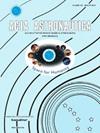用于大气呼吸电力推进(ABEP)系统的无阴极射频等离子推进器的设计与优化
IF 3.1
2区 物理与天体物理
Q1 ENGINEERING, AEROSPACE
引用次数: 0
摘要
大气呼吸电力推进器(ABEP)是一种利用残余大气气体作为电力推进器推进剂来源的概念,无需机载推进剂存储。这将实现持续的低推力阻力补偿,延长极低地球轨道(VLEO)上航天器的寿命。甚低地球轨道对航天器的运行来说是一个很有吸引力的区域,它可以执行新的遥感任务,提高辐射性能和空间分辨率,同时减小体积、质量和功率要求,降低任务成本。因此,对 ABEP 系统进行了初步设计审查和优化,该系统使用了 Technology for Innovation & Propulsion (T4i) S.p.A. 公司的无阴极射频(RF)等离子推进器。我们开发了一个半经验氧氮全球源模型(GSM),该模型考虑了射频放电的体积平均通量、动量和能量平衡。其中包括电离室中复杂的电子-分子反应和空气等离子体能量损失通道的详细化学模型。GSM 与进气口的通量平衡分析模型相结合,并通过直接模拟蒙特卡洛(DSMC)仿真进行验证,以考虑最大收集效率的设计。然后利用该模型对 ABEP 系统进行稳健的多目标优化,同时考虑航天器空气动力学和功率要求。本文章由计算机程序翻译,如有差异,请以英文原文为准。
Cathode-less RF plasma thruster design and optimisation for an atmosphere-breathing electric propulsion (ABEP) system
Atmosphere-breathing electric propulsion (ABEP) is a concept that ingests residual atmospheric gases as a source of propellant for an electric thruster, removing the need for onboard propellant storage. This would enable continuous low-thrust drag compensation, extending the lifetime of spacecraft in Very-Low Earth Orbit (VLEO); 250 km. VLEO is an appealing region for spacecraft operations, enabling new remote sensing missions with improved radiometric performance and spatial resolution, whilst reducing size, mass and power requirements, as well as mission cost. A preliminary design review and optimisation is therefore conducted for an ABEP system that uses the cathode-less radio frequency (RF) plasma thruster from Technology for Innovation & Propulsion (T4i) S.p.A. This removes the issue of thruster erosion by means of magnetic confinement and offers reduced susceptibility to varying atmospheric composition. A semi-empirical oxygen-nitrogen global source model (GSM) has been developed which considers the volume-averaged flux, momentum, and energy balance of the RF discharge. This includes a detailed chemistry model for the complex electron-molecular reactions and energy-loss channels of air plasma in the ionisation chamber. The GSM is coupled to an analytical model of flux balance for an air intake, verified by Direct Simulation Monte-Carlo (DSMC) simulation, to consider its design for maximum collection efficiency. This is then utilised in a robust multi-objective optimisation of the ABEP system, accounting also for spacecraft aerodynamics and power requirements.
求助全文
通过发布文献求助,成功后即可免费获取论文全文。
去求助
来源期刊

Acta Astronautica
工程技术-工程:宇航
CiteScore
7.20
自引率
22.90%
发文量
599
审稿时长
53 days
期刊介绍:
Acta Astronautica is sponsored by the International Academy of Astronautics. Content is based on original contributions in all fields of basic, engineering, life and social space sciences and of space technology related to:
The peaceful scientific exploration of space,
Its exploitation for human welfare and progress,
Conception, design, development and operation of space-borne and Earth-based systems,
In addition to regular issues, the journal publishes selected proceedings of the annual International Astronautical Congress (IAC), transactions of the IAA and special issues on topics of current interest, such as microgravity, space station technology, geostationary orbits, and space economics. Other subject areas include satellite technology, space transportation and communications, space energy, power and propulsion, astrodynamics, extraterrestrial intelligence and Earth observations.
 求助内容:
求助内容: 应助结果提醒方式:
应助结果提醒方式:


